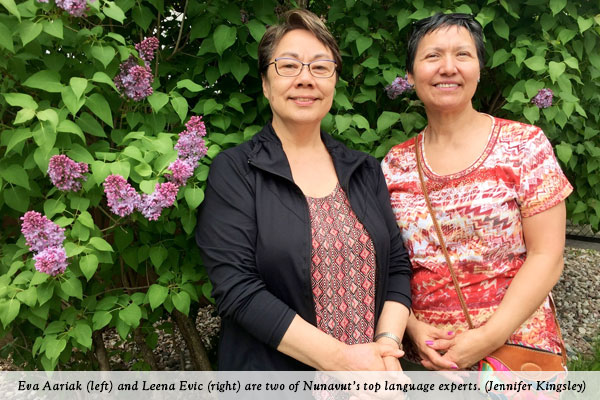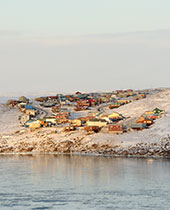Nunavut’s language experts looked to the past to invent new words for the digital age. “Meet the North,” a series that ventures into the lives of some of the 4 million people who call the Arctic home, learns how a language stays strong in the Facebook era.
OTTAWA – I’m sitting at a patio table with two of Nunavut’s foremost language experts, Leena Evic and Eva Aariak. We’re in Eva’s backyard drinking tea, eating homemade cookies and talking about the internet. And they’re about to blow my mind.
The Inuktitut word for internet, “ikiaqqijjut,” is often translated as “the tool to travel through layers.” But Eva stresses that it needs more explanation.
“The idea is that when shamans are in their trance, they can go anywhere around the world, including the moon,” Eva says. “When our elders heard there was the first man on the moon, they said, ‘They are not the first. We have been there and done that,’ because shamans have been there. Shamans would travel in a trance; if they want to check on their family far away, they can visit them and see how they’re doing.”
“While their body is right here,” says Leena.
“That’s what internet does, eh?” says Eva, “Especially with Facebook now, too, you can see how your family is doing.”

An understanding of spiritual layers and the nonlinear nature of things drove the selection of this particular word. Part of keeping Inuktitut strong is finding words for the changing world around us.
“With our ancestors, Inuktitut was complete,” says Eva, who was both Nunavut’s languages commissioner and its premier before becoming the director of language programs for the Pirurvik Centre for Inuit Language, Culture and Wellbeing.
Out on the land, everything has an Inuktitut word. But move into a community or a city – and especially the office – and you need a broader vocabulary. In Nunavut, a small team of dedicated language advocates have been trying to keep up with computers, smartphones and social media. It’s a lot of work bringing Inuktitut into the digital age.
In the 1980s and 1990s, as personal computers became part of our everyday lives, Inuktitut speakers began to create or repurpose words to describe digital objects and actions. The word for computer, “qarasaujaq,” means “like that of a brain.” (The same word was chosen in Greenland through an unrelated but parallel process.) But a few new words could not keep up with the rate of change.
In 2004, the small team at Pirurvik, led by Leena and co-founder Gavin Nesbitt, decided to take a big leap: They would work with Microsoft to add Inuktitut to a small group of indigenous languages supported by the Microsoft operating system and Office Suite. “We were catching up on almost 50 years of terminology,” says Gavin.
To do so, they would need a base glossary of 2,000 terms at the outset, which would expand over time. Some were chosen by committee at terminology development workshops, but the sheer volume was too much for that process every time. Individual experts needed to invent language, and fast. “The deadlines were brutal,” says Leena.
Pirurvik worked with Microsoft teams around the world on rolling out the next update and then the next. “Sometimes there was a deadline every weekend,” says Leena.
The terms themselves are a fascinating collection. Some are practical; for example, folder is “puurvik,” a “place to put things in.” Some are fun; a computer mouse is “avinngannguaq,” a “fake lemming.” Other words are whimsical; Microsoft’s help wizard (remember him?) is “ikajuqti’naaq,” which means “little helper,” a word from central Nunavut.
But the terms were just the beginning. Think about the menus in your word processor (never mind spreadsheets or file management systems). Word length, spacing and consistency are critical, and there is a lot of nuance. For example, English terms such as “quit,” “exit,” “log off” and “cancel” mean approximately the same thing, but they are designated for highly specific tasks. English drives computer terminology and localizing it to a new language, with a completely different linguistic logic, was a mammoth task.
Another challenge was coordination. Even though Pirurvik successfully made Inuktitut available through Microsoft, the government of Nunavut never rolled it out on a large scale. By the time Microsoft was working on Windows 8 and Office 2013, Leena, Gavin and their colleagues were worn out.
“I wouldn’t recommend it to a language that doesn’t have spare capacity,” says Gavin. “It will take your top people months of their life every year.” He believes that in many places, those top people should be talking to people and telling stories, not working on the computer.
On the other hand, “We are keeping Inuktitut alive through the media,” says Leena, “I don’t need to speak in English whatsoever, because the language is there now. It created a wonderful glossary of terms that enabled Inuktitut to be part of the internet age.”
With the work of these experts, who have moved on to syllabic keyboards, new apps, a grammar dictionary and all kinds of courses, the language stays current. In words such as “ikiaqqijjut” (internet), ancestors remain present, and so is the vision that Inuktitut will be complete again.
If you're planning to visit the Arctic, view our departures here!
Article originally posted on News Deeply.
The Inuktitut word for internet, “ikiaqqijjut,” is often translated as “the tool to travel through layers.” But Eva stresses that it needs more explanation.
“The idea is that when shamans are in their trance, they can go anywhere around the world, including the moon,” Eva says. “When our elders heard there was the first man on the moon, they said, ‘They are not the first. We have been there and done that,’ because shamans have been there. Shamans would travel in a trance; if they want to check on their family far away, they can visit them and see how they’re doing.”
“While their body is right here,” says Leena.
“That’s what internet does, eh?” says Eva, “Especially with Facebook now, too, you can see how your family is doing.”

An understanding of spiritual layers and the nonlinear nature of things drove the selection of this particular word. Part of keeping Inuktitut strong is finding words for the changing world around us.
“With our ancestors, Inuktitut was complete,” says Eva, who was both Nunavut’s languages commissioner and its premier before becoming the director of language programs for the Pirurvik Centre for Inuit Language, Culture and Wellbeing.
Out on the land, everything has an Inuktitut word. But move into a community or a city – and especially the office – and you need a broader vocabulary. In Nunavut, a small team of dedicated language advocates have been trying to keep up with computers, smartphones and social media. It’s a lot of work bringing Inuktitut into the digital age.
In the 1980s and 1990s, as personal computers became part of our everyday lives, Inuktitut speakers began to create or repurpose words to describe digital objects and actions. The word for computer, “qarasaujaq,” means “like that of a brain.” (The same word was chosen in Greenland through an unrelated but parallel process.) But a few new words could not keep up with the rate of change.
In 2004, the small team at Pirurvik, led by Leena and co-founder Gavin Nesbitt, decided to take a big leap: They would work with Microsoft to add Inuktitut to a small group of indigenous languages supported by the Microsoft operating system and Office Suite. “We were catching up on almost 50 years of terminology,” says Gavin.
To do so, they would need a base glossary of 2,000 terms at the outset, which would expand over time. Some were chosen by committee at terminology development workshops, but the sheer volume was too much for that process every time. Individual experts needed to invent language, and fast. “The deadlines were brutal,” says Leena.
Pirurvik worked with Microsoft teams around the world on rolling out the next update and then the next. “Sometimes there was a deadline every weekend,” says Leena.
The terms themselves are a fascinating collection. Some are practical; for example, folder is “puurvik,” a “place to put things in.” Some are fun; a computer mouse is “avinngannguaq,” a “fake lemming.” Other words are whimsical; Microsoft’s help wizard (remember him?) is “ikajuqti’naaq,” which means “little helper,” a word from central Nunavut.
But the terms were just the beginning. Think about the menus in your word processor (never mind spreadsheets or file management systems). Word length, spacing and consistency are critical, and there is a lot of nuance. For example, English terms such as “quit,” “exit,” “log off” and “cancel” mean approximately the same thing, but they are designated for highly specific tasks. English drives computer terminology and localizing it to a new language, with a completely different linguistic logic, was a mammoth task.
Another challenge was coordination. Even though Pirurvik successfully made Inuktitut available through Microsoft, the government of Nunavut never rolled it out on a large scale. By the time Microsoft was working on Windows 8 and Office 2013, Leena, Gavin and their colleagues were worn out.
“I wouldn’t recommend it to a language that doesn’t have spare capacity,” says Gavin. “It will take your top people months of their life every year.” He believes that in many places, those top people should be talking to people and telling stories, not working on the computer.
On the other hand, “We are keeping Inuktitut alive through the media,” says Leena, “I don’t need to speak in English whatsoever, because the language is there now. It created a wonderful glossary of terms that enabled Inuktitut to be part of the internet age.”
With the work of these experts, who have moved on to syllabic keyboards, new apps, a grammar dictionary and all kinds of courses, the language stays current. In words such as “ikiaqqijjut” (internet), ancestors remain present, and so is the vision that Inuktitut will be complete again.
If you're planning to visit the Arctic, view our departures here!
Article originally posted on News Deeply.



